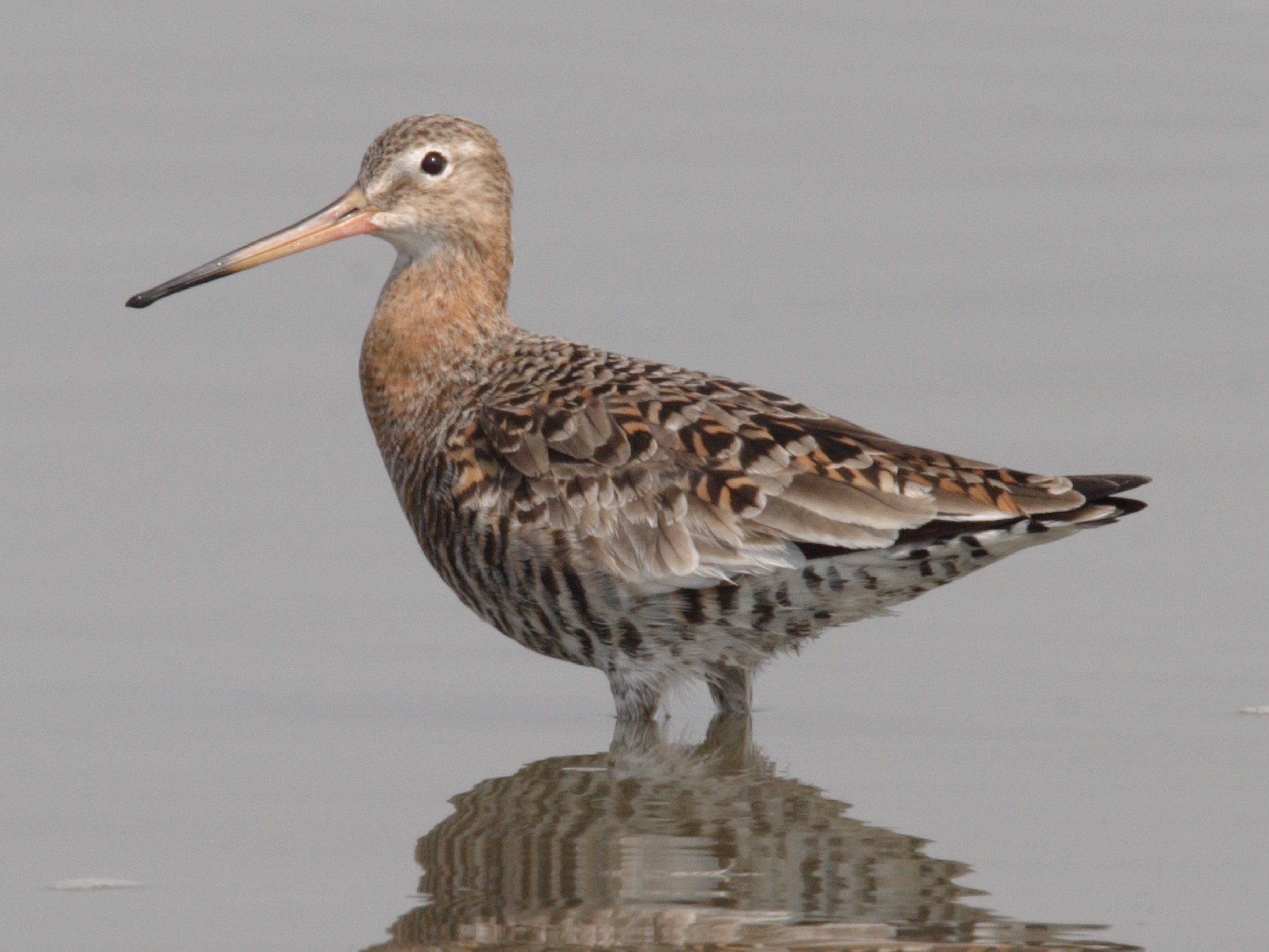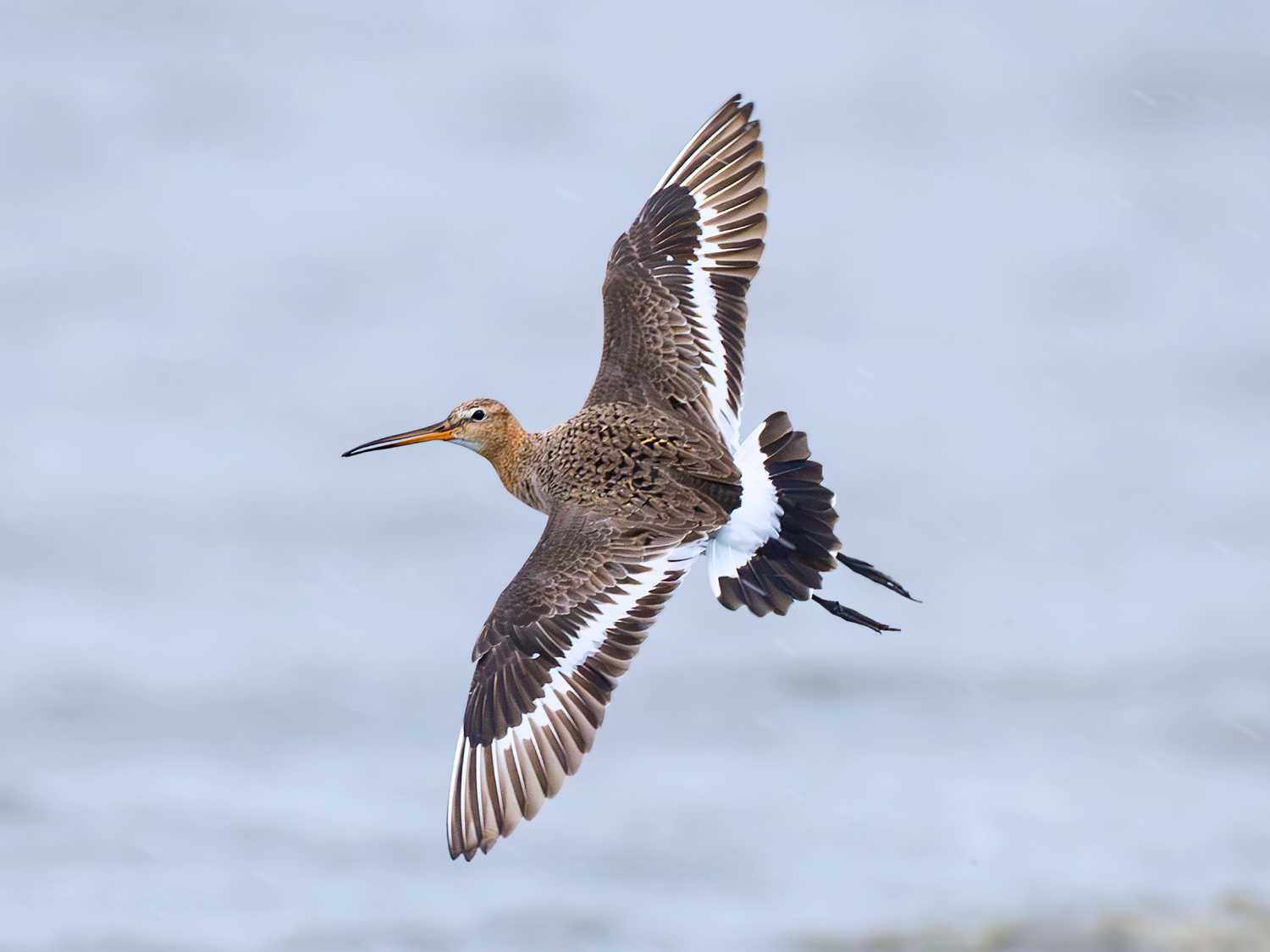Black-tailed Godwit Limosa limosa 黑尾塍鷸
Category I. Abundant winter visitor and passage migrant in spring, with different subspecies dominating in each season. L. l. melanuroides passes through in large numbers in spring and in small numbers in autumn; L. l. bohaii winters in large numbers but is rare in spring.
IDENTIFICATION

Mar. 2021, Michelle and Peter Wong.
36-44 cm. In breeding plumage, the migrant taxon melanuroides has rusty-orange on chest and flanks and whitish belly, with the area below the middle of the chest barred blackish, broader on the flanks (males have more intense and more extensive rusty-orange). Upperpart feathers are black and rust. Basal half of bill orange.

Oct. 2020, K. C. Kong.
Differs structurally from Bar-tailed Godwit in being smaller and by shorter (taxon melanuroides) straight or nearly straight bill, proportionately longer legs and more mobile, probing and less vigorous foraging action.
In non-breeding plumage melanuroides has plain grey-brown upperparts and chest. Juvenile has warm buff tones to head and chest and pale-fringed wing coverts.

Apr. 2023, Michelle and Peter Wong.
Distinguished in flight by obvious broad white wing bar across secondaries and most primaries, and black tail contrasting with white rump and bases to the outer tail feathers.

Mar. 2021, Michelle and Peter Wong.
The wintering taxon bohaii is larger and longer-billed than migrant melanuroides. Birds that remain until early spring (usually second calendar-year) stand out for their size, bill length and lack of breeding plumage.
VOCALISATIONS
Can be vocal in flight, but usually much less so on the ground. The typical call of a flock of birds approaching a roosting or foraging area is a moderately high-pitched ‘wit-tu wit-tu’.
DISTRIBUTION & HABITAT PREFERENCE
Most records are from the intertidal mudflats of Deep Bay and adjacent roosting areas, primarily Mai Po NR, and very rarely on commercial fish ponds. There are rather few records away from here at Sai Kung, Shuen Wan, Starling Inlet, Long Valley and in flight over the airport at Chek Lap Kok.
OCCURRENCE
Spring passage of L. l. melanuroides is usually apparent from the middle of March. The main spring passage period occurs during April (Figure 1) with peak numbers generally occurring during the middle two weeks. The highest count in spring, and the highest on record in HK, is 2,400 on 4 April 2013. A substantial departure occurs by the end of April, and there are no three-figure counts after the first week of May.
Up to 40 birds have been noted in June and the first half of July, with return passage evident from the final week of the month. Although Figure 1 indicates that numbers increase gradually during passage to peak in the first week of November, other counts indicate that actually there is simply a gradual build up in numbers as the wintering population establishes.
Figure 2 illustrates the increase in the number of wintering birds that has occurred since winter waterbird counts commenced. While the very low number present up to the mid-1980s was no doubt due to limited access to the intertidal areas of Deep Bay, subsequently there was a sustained increase until winter 2010/11 when 1,900 birds were recorded (all, on the day of the count, on the Shenzhen side of Deep Bay). Numbers have remained relatively high in recent years, however, and include the highest winter count in HK of 895 on 14 February 2016.
There is one HK-related ringing recovery: a bird ringed at Mai Po on 16 April 1988 was hunted at the Red River delta, Vietnam in March 1990.
Black-tailed Godwit was first recorded in HK on 10 October 1954 (Herklots 1967); subsequently, up to ten were noted in autumn up to 1958, when records were first collected by the HKBWS.
BEHAVIOUR, FORAGING & DIET
Highly gregarious forming large flocks for roosting and foraging from autumn through to spring.
RANGE & SYSTEMATICS
Breeds from Iceland east through northern and eastern Europe, western Russia, and northern Kazakhstan to western Mongolia, with disjunct populations scattered through eastern Siberia, Kamchatka, Ussuriland and northeast China. Winters around the Mediterranean, sub-Saharan Africa, southwest Asia, the Indian subcontinent, Indochina, south China, Indonesia, New Guinea and Australia (Van Gils et al. 2020). In China L. l. melanuroides breeds in Xinjiang, Inner Mongolia and the northeast, and both subspecies are migrants mainly along the east coast (Liu and Chen 2020), while wintering birds along the south China coast, including Hainan and Taiwan, are L. l. bohaii. Zhu et al. (2021) indicate that L. l. bohaii wintering in Thailand migrate to the north of HK directly to Bohai Bay.
Four subspecies are recognised, two of which occur in Hong Kong. L. l. melanuroides passes through in large numbers in spring; L. l. bohaii winters in large numbers. The remaining two subspecies breed from Iceland east to Central Asia.
CONSERVATION STATUS
IUCN: Near-threatened. Population trend decreasing rapidly in parts of its range due to agricultural practices.
Figure 1.

Figure 2.

Herklots, G. A. C. (1967). Hong Kong Birds (2nd ed.). South China Morning Post, Hong Kong.
Liu, Y. and Y. H. Chen (eds) (2020). The CNG Field Guide to the Birds of China (in Chinese). Hunan Science and Technology Publication House, Changsha.
Van Gils, J., P. Wiersma, D. A. Christie, E. F. J. Garcia, and P. F. D. Boesman (2020). Black-tailed Godwit (Limosa limosa), version 1.0. In Birds of the World (J. del Hoyo, A. Elliott, J. Sargatal, D. A. Christie, and E. de Juana, Editors). Cornell Lab of Ornithology, Ithaca, NY, USA. https://doi.org/10.2173/bow.bktgod.01
Zhu, B. R., M. A. Verhoeven, J. Loonstra, L. Sánchez, C. Hassell, K. Leung, W. P. Lei, Z. W. Zhang and T. Piersma (2021). Identification of breeding grounds and annual routines of the newly discovered bohaii subspecies of Black-tailed Godwits. Emu. 10.1080/01584197.2021.1963287.

